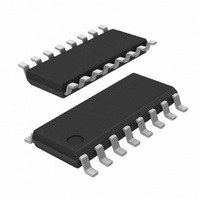SI3010-F-GS Silicon Laboratories Inc, SI3010-F-GS Datasheet - Page 14

SI3010-F-GS
Manufacturer Part Number
SI3010-F-GS
Description
IC ISOMODEM LINE-SIDE 16SOIC
Manufacturer
Silicon Laboratories Inc
Datasheet
1.SI3010-F-GS.pdf
(76 pages)
Specifications of SI3010-F-GS
Data Format
V.92
Interface
Serial
Voltage - Supply
3 V ~ 3.6 V
Mounting Type
Surface Mount
Package / Case
16-SOIC (3.9mm Width)
Lead Free Status / RoHS Status
Lead free / RoHS Compliant
Baud Rates
-
Lead Free Status / RoHS Status
Lead free / RoHS Compliant, Lead free / RoHS Compliant
Si2401
4.2.1. Command/Data Mode
Upon reset, the modem is in command mode and
accepts AT-style commands. An outgoing modem call
can be made using the “ATDT#” (tone dial) or “ATDP#”
(pulse dial) command after the device is configured. If
the handshake is successful, the modem responds with
the “c”, “d”, or “v” string and enters data mode. (The
byte following the “c”, “d”, or “v” is the first data byte.) At
this point, AT-style commands are not accepted. There
are three methods that may be used to return the
Si2401 to command mode:
Whether using an escape method or not, when the
carrier is lost, the modem automatically returns to
command mode and reports “N”.
4.2.2. 8-Bit Data Mode (8N1)
The 8-bit data mode is the default mode after powerup
or reset and is set by SE0[3] (ND) = 0
asynchronous, full duplex, and uses a total of 10 bits
including a start bit (logic 0), eight data bits, and a stop
bit (logic 1). Data received from the remote modem is
transferred from the Si2401 to the host on the RXD pin.
Data transfer to the host begins when the Si2401
asserts a logic 0 start bit on RXD. Data is shifted out of
the Si2401 LSB first at the DTE rate determined by the
SE0[2:0] (SD) setting and terminates with a stop bit.
Data from the host for transmission to the remote
modem is shifted to the Si2401 on TXD beginning with a
start bit, LSB, first at the DTE rate determined by the
SE0[2:0] setting, and terminates with a stop bit.
14
Use the ESC pin—To program the GPIO3 pin to
function as an ESCAPE input, set GPIO3
SE2[5:4] = 11. In this setting, a positive edge
detected on this pin returns the modem to command
mode. The “ATO” string can be used to reenter data
mode.
Use 9-bit data mode—If 9-bit data format with
escape is programmed, a 1 detected on bit 9 returns
the modem to command mode. (See Figure 2 on
page 9.) This is enabled by setting SE0[3] (ND) = 1
and S15[0] (NBE) = 1. The ATO string can be used
to reenter data mode. Ninth bit escape does not
work in the security modes.
Use “+++”—The escape sequence is a sequence of
three escape characters that are set in S-register
S0F (“+” characters by default). If the ISOmodem
chipset detects the “+++” sequence and detects no
activity on the UART before or after the “+++”
sequence for a time period set by S-register S10, it
returns to command mode. To disable this escape
sequence, set S-register S10 = FF. To remove the
time-dependent behavior, set S-register S10 = 00.
b
. It is
®
Rev. 1.0
After the middle of the stop bit time, the Si2401 begins
looking for a logic 1 to logic 0 transition signaling the
start of the next character on TXD to be sent to the line
(remote modem).
4.2.3. 9-Bit Data Mode (9N1)
The 9-bit data mode is set by SE0[3] (ND) = 1. It is
asynchronous, full duplex, and uses a total of 11 bits
including a start bit (logic 0), 9 data bits, and a stop bit
(logic 1). Data received from the line (remote modem) is
transferred from the Si2401 to the host on the RXD pin.
Data transfer to the host begins when the Si2401
asserts a logic 0 start bit on RXD. Data is shifted out of
the Si2401 LSB first at the DTE rate determined by the
SE0[2:0] (SD) setting and terminates with a stop bit.
Data from the host for transmission to the line (remote
modem) is shifted to the Si2401 on TXD beginning with
a start bit, LSB, first at the DTE rate determined by the
S-Register SE0[2:0] (SD) setting, and terminates with a
stop bit. After the middle of the stop bit time, the Si2401
begins looking for a logic 1 to logic 0 transition signaling
the start of the next character on TXD to be sent to the
line (remote modem).
The ninth data bit may be used to indicate an escape by
setting S15[0] (NBE) = 1. In this mode, the ninth data bit
is normally set to 0 when the modem is online. When
the ninth data bit is set to 1, the modem goes offline into
command mode, and the next frame is interpreted as an
AT command. Data mode can be reentered using the
ATO command.
4.2.4. Flow Control
No flow control is needed if the DTE rate and DCE rate
are the same. If the serial link (DTE) data rate is set
higher than the line (DCE) rate of the modem, flow
control is required to prevent loss of data to the
transmitter.
To control data flow, the clear-to-send (CTS) pin is used.
When CTS is asserted, the Si2401 is ready to accept a
character. While CTS is negated, no data should be
sent to the Si2401 on TXD. To simplify flow control, the
Si2401 has an integrated ten character transmit FIFO
and allows for two different CTS reporting methods. By
default, the CTS pin is negated as soon as a start bit is
detected on the TXD pin and remains negated until the
modem is ready to accept another character (see
Figure 2 on page 9.) By setting SFC7[7] = 1 (CTSM),
CTS is negated when the FIFO is 70% full and is
reasserted when the FIFO is 30% full.













